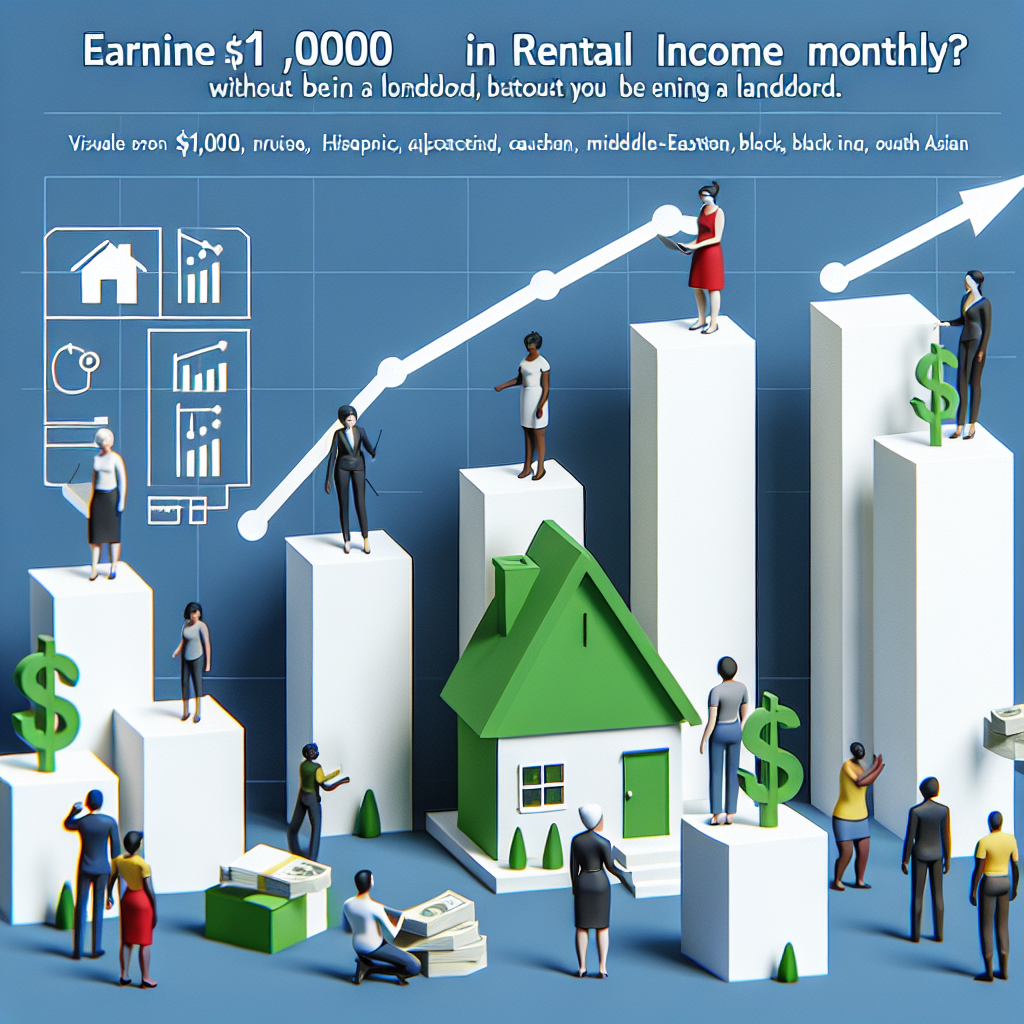“Unlock Passive Income: Earn $1,000 Monthly Without Owning Property!”
Introduction
In today’s dynamic financial landscape, generating passive income has become an increasingly attractive goal for many individuals seeking financial freedom and stability. One intriguing avenue to explore is earning rental income without the traditional responsibilities and challenges of being a landlord. This innovative approach allows individuals to tap into the lucrative real estate market and earn $1,000 or more monthly, all while sidestepping the common pitfalls associated with property management. By leveraging modern investment strategies and platforms, it’s possible to enjoy the benefits of rental income without the need to own or manage physical properties. Discover how this can be achieved and unlock the potential for a steady, hassle-free income stream.
Real Estate Investment Trusts (REITs)
Real Estate Investment Trusts (REITs) offer a compelling avenue for individuals seeking to earn rental income without the traditional responsibilities of being a landlord. These investment vehicles allow individuals to invest in real estate portfolios, which generate income through various properties such as commercial buildings, apartments, and shopping centers. By purchasing shares in a REIT, investors can earn a portion of the income produced by these properties, often distributed as dividends. This approach provides a unique opportunity for those interested in real estate to benefit from rental income without the need to manage properties directly.
One of the primary advantages of investing in REITs is the potential for consistent income. REITs are required by law to distribute at least 90% of their taxable income to shareholders in the form of dividends. This requirement ensures that investors receive a steady stream of income, which can be particularly appealing for those looking to supplement their earnings. For individuals aiming to earn $1,000 monthly, investing in REITs can be an effective strategy, provided they carefully select the right REITs and allocate their investments wisely.
To achieve a monthly income of $1,000 from REITs, investors must consider several factors, including the dividend yield and the amount of capital invested. The dividend yield represents the annual dividend payment expressed as a percentage of the share price. For instance, if a REIT has a dividend yield of 5%, an investor would need to invest approximately $240,000 to generate $1,000 per month, assuming the yield remains constant. However, it is crucial to note that dividend yields can fluctuate based on market conditions and the performance of the underlying properties.
Diversification is another key consideration for investors seeking to earn rental income through REITs. By investing in a diverse range of REITs, individuals can mitigate risks associated with specific sectors or geographic locations. For example, an investor might choose to allocate funds across residential, commercial, and industrial REITs to ensure a balanced portfolio. This diversification can help protect against market volatility and provide a more stable income stream.
Moreover, REITs offer liquidity that traditional real estate investments do not. Shares in publicly traded REITs can be bought and sold on major stock exchanges, providing investors with the flexibility to adjust their portfolios as needed. This liquidity is particularly advantageous for those who may need to access their funds quickly or wish to reallocate their investments in response to changing market conditions.
In addition to liquidity, REITs provide a level of transparency that is often lacking in direct real estate investments. Publicly traded REITs are subject to regulatory oversight and must adhere to strict reporting requirements, ensuring that investors have access to detailed information about the REIT’s financial performance and property holdings. This transparency allows investors to make informed decisions and assess the potential risks and rewards associated with their investments.
In conclusion, Real Estate Investment Trusts present a viable option for individuals seeking to earn rental income without the burdens of property management. By understanding the dynamics of dividend yields, diversifying their investments, and taking advantage of the liquidity and transparency offered by REITs, investors can work towards achieving a monthly income of $1,000. As with any investment, it is essential to conduct thorough research and consider one’s financial goals and risk tolerance before committing capital to REITs.
Crowdfunding Platforms for Real Estate
In recent years, the landscape of real estate investment has undergone a significant transformation, largely due to the advent of crowdfunding platforms. These platforms have democratized access to real estate investments, allowing individuals to earn rental income without the traditional responsibilities of being a landlord. This shift has opened up opportunities for many to earn a steady income stream, with some investors making $1,000 or more monthly. Understanding how these platforms work and the potential they hold is crucial for anyone looking to diversify their investment portfolio.
Crowdfunding platforms for real estate operate by pooling funds from multiple investors to finance real estate projects. This model allows individuals to invest in properties with relatively small amounts of capital, which would otherwise be inaccessible to them. By doing so, investors can earn a share of the rental income generated by these properties. The process is straightforward: investors choose a project, contribute funds, and receive returns based on the performance of the investment. This method not only reduces the financial barrier to entry but also mitigates the risks associated with owning and managing property directly.
Moreover, these platforms offer a variety of investment options, ranging from residential and commercial properties to more niche markets like student housing or senior living facilities. This diversity enables investors to tailor their portfolios according to their risk tolerance and financial goals. For instance, some platforms focus on high-yield, short-term investments, while others emphasize long-term growth and stability. This flexibility is particularly appealing to those who wish to earn passive income without the day-to-day hassles of property management.
In addition to the financial benefits, real estate crowdfunding platforms provide a level of transparency and accessibility that traditional real estate investments often lack. Investors can easily access detailed information about each project, including financial projections, property details, and market analysis. This transparency empowers investors to make informed decisions and track the performance of their investments in real-time. Furthermore, many platforms offer educational resources and customer support to help investors navigate the complexities of real estate investing.
Despite these advantages, it is important to acknowledge the potential risks associated with real estate crowdfunding. As with any investment, there is no guarantee of returns, and investors may face challenges such as market volatility or project delays. Therefore, conducting thorough due diligence and understanding the specific terms and conditions of each investment is essential. Additionally, diversifying investments across multiple projects and platforms can help mitigate risks and enhance the potential for earning consistent rental income.
In conclusion, real estate crowdfunding platforms have revolutionized the way individuals can earn rental income without the traditional burdens of being a landlord. By offering accessible, transparent, and diverse investment opportunities, these platforms enable investors to earn significant returns, with some achieving $1,000 or more in monthly rental income. As the real estate market continues to evolve, these platforms are likely to play an increasingly important role in the investment landscape. For those seeking to explore new avenues for passive income, real estate crowdfunding presents a compelling option that combines the benefits of real estate investment with the convenience and flexibility of modern technology.
Short-Term Rental Arbitrage
Short-term rental arbitrage has emerged as a compelling strategy for individuals seeking to earn a substantial income from rental properties without the traditional responsibilities of being a landlord. This innovative approach allows individuals to capitalize on the booming short-term rental market, driven by platforms like Airbnb and Vrbo, without the need to own property. By understanding the mechanics of rental arbitrage, many have discovered the potential to earn $1,000 or more monthly, making it an attractive option for those looking to diversify their income streams.
At its core, short-term rental arbitrage involves leasing a property from a landlord and then subletting it on a short-term rental platform. The key to success in this venture lies in the ability to negotiate favorable lease terms with property owners while ensuring compliance with local regulations and the terms of the lease agreement. By doing so, individuals can effectively manage the property as a short-term rental, charging higher nightly rates than the monthly rent they pay, thus generating a profit.
One of the primary advantages of rental arbitrage is the relatively low barrier to entry compared to traditional real estate investment. Unlike purchasing a property, which requires significant capital and often involves complex financing arrangements, rental arbitrage typically requires only the first month’s rent and a security deposit. This makes it accessible to a broader range of individuals, including those who may not have the financial means to invest in real estate directly.
Moreover, rental arbitrage offers flexibility and scalability. Individuals can start with a single property and gradually expand their portfolio as they gain experience and confidence in managing short-term rentals. This scalability is particularly appealing in urban areas with high demand for short-term accommodations, where savvy operators can leverage multiple properties to maximize their earnings.
However, it is essential to approach rental arbitrage with a thorough understanding of the local market and regulations. Many cities have implemented strict rules governing short-term rentals, including licensing requirements, occupancy limits, and zoning restrictions. Failure to comply with these regulations can result in fines and legal issues, potentially jeopardizing the profitability of the venture. Therefore, conducting comprehensive research and, if necessary, consulting with legal experts is crucial before embarking on a rental arbitrage strategy.
In addition to regulatory considerations, successful rental arbitrage requires effective property management skills. This includes maintaining the property in excellent condition, providing exceptional customer service to guests, and optimizing pricing strategies to ensure high occupancy rates. Utilizing technology, such as dynamic pricing tools and property management software, can streamline operations and enhance profitability.
Furthermore, building strong relationships with property owners is vital. Transparent communication and demonstrating the value of a partnership can help secure favorable lease terms and foster long-term collaborations. By presenting rental arbitrage as a mutually beneficial arrangement, individuals can alleviate potential concerns landlords may have about subletting their properties.
In conclusion, short-term rental arbitrage presents a viable opportunity for individuals to earn $1,000 or more monthly without the traditional responsibilities of being a landlord. By leveraging the demand for short-term accommodations and employing strategic management practices, individuals can capitalize on this innovative approach to real estate. However, success in rental arbitrage requires careful planning, compliance with regulations, and a commitment to providing exceptional guest experiences. With these elements in place, rental arbitrage can serve as a lucrative and sustainable income stream in today’s dynamic rental market.
Real Estate Syndications

Real estate syndications have emerged as a compelling investment avenue for individuals seeking to earn passive income without the traditional responsibilities of being a landlord. This innovative approach allows investors to pool their resources to acquire larger properties, such as apartment complexes or commercial buildings, which would be difficult to purchase individually. By participating in a syndication, investors can earn a share of the rental income generated by these properties, often amounting to $1,000 or more monthly, without the need to manage tenants or maintain properties themselves.
The concept of real estate syndication is not new, but it has gained significant traction in recent years due to the increasing accessibility of information and the rise of online platforms that facilitate these investments. These platforms connect investors with experienced syndicators, who are responsible for identifying, acquiring, and managing the properties. This arrangement allows investors to benefit from the expertise of seasoned professionals while diversifying their investment portfolios.
One of the primary advantages of real estate syndications is the ability to invest in high-quality properties that would otherwise be out of reach for individual investors. By pooling funds, syndications can acquire properties in prime locations, which tend to offer more stable and lucrative rental income. Furthermore, these properties are often managed by professional property management companies, ensuring that they are well-maintained and that tenant issues are handled efficiently. This professional management is a key factor in generating consistent rental income, which is then distributed to investors.
Moreover, real estate syndications offer a level of diversification that is difficult to achieve through direct property ownership. Investors can participate in multiple syndications across different markets and property types, thereby spreading their risk. This diversification can be particularly beneficial in mitigating the impact of market fluctuations, as the performance of one property or market may offset the underperformance of another. Consequently, investors can enjoy a more stable income stream, which is a significant advantage over traditional real estate investments.
In addition to diversification, real estate syndications provide investors with a passive income stream, which is one of their most attractive features. Unlike direct property ownership, where landlords must deal with tenant issues, maintenance, and other management tasks, syndication investors can enjoy the financial benefits without the associated headaches. This passive nature of the investment makes it an appealing option for those who wish to supplement their income without taking on additional responsibilities.
Furthermore, the potential for earning $1,000 or more monthly in rental income through syndications is not merely theoretical. Many investors have successfully achieved this level of income by carefully selecting syndications with strong track records and favorable market conditions. It is important, however, for investors to conduct thorough due diligence before committing their funds. This includes evaluating the syndicator’s experience, the property’s location and condition, and the overall market trends.
In conclusion, real estate syndications offer a viable path for individuals seeking to earn substantial rental income without the burdens of traditional property ownership. By leveraging the expertise of professional syndicators and diversifying their investments, investors can achieve a steady and passive income stream. As more people become aware of the benefits of syndications, it is likely that this investment model will continue to grow in popularity, providing an accessible and efficient means of participating in the lucrative real estate market.
Peer-to-Peer Lending in Real Estate
In recent years, the landscape of real estate investment has evolved significantly, offering innovative avenues for individuals to earn income without the traditional responsibilities of property ownership. One such avenue is peer-to-peer lending in real estate, a model that has gained traction among investors seeking to earn rental income without the burdens of being a landlord. This approach allows individuals to invest in real estate projects by lending money to developers or property owners, who, in turn, use these funds to finance their ventures. As a result, investors can earn a steady stream of income, often amounting to $1,000 or more monthly, without the need to manage properties directly.
The concept of peer-to-peer lending in real estate is rooted in the broader trend of crowdfunding, where multiple investors pool their resources to fund a project. This model democratizes real estate investment, making it accessible to a wider audience who may not have the capital to purchase properties outright. By participating in these platforms, investors can diversify their portfolios, spreading their risk across multiple projects rather than concentrating it in a single property. This diversification is particularly appealing in the volatile real estate market, where fluctuations can significantly impact returns.
Moreover, peer-to-peer lending platforms offer a level of transparency and control that traditional real estate investments often lack. Investors can choose specific projects that align with their risk tolerance and financial goals, whether they prefer residential developments, commercial properties, or mixed-use projects. These platforms typically provide detailed information about each project, including expected returns, timelines, and potential risks, enabling investors to make informed decisions. This level of control is a significant advantage for those who wish to actively manage their investment strategies without the day-to-day responsibilities of property management.
In addition to transparency and control, peer-to-peer lending in real estate offers the potential for attractive returns. While returns can vary based on the project’s success and market conditions, many investors report earning $1,000 or more monthly from their investments. This income is generated through interest payments made by the borrowers, who use the funds to complete their real estate projects. As these projects succeed and generate revenue, investors receive their share of the profits, creating a passive income stream that can supplement or even replace traditional earnings.
Furthermore, the rise of technology has facilitated the growth of peer-to-peer lending platforms, making it easier than ever for investors to participate. With user-friendly interfaces and robust security measures, these platforms provide a seamless experience for both novice and experienced investors. They also offer educational resources and customer support to help investors navigate the complexities of real estate investment, ensuring that they have the tools and knowledge needed to succeed.
In conclusion, peer-to-peer lending in real estate presents a compelling opportunity for individuals to earn rental income without the challenges of being a landlord. By leveraging the power of crowdfunding and technology, investors can access a diverse range of projects, enjoy transparency and control over their investments, and potentially earn significant returns. As this model continues to gain popularity, it is poised to reshape the real estate investment landscape, offering a viable alternative for those seeking to build wealth through real estate without the traditional constraints.
Investing in Real Estate Notes
Investing in real estate has long been a popular avenue for generating passive income, but the traditional route of becoming a landlord is not without its challenges. From property maintenance to tenant management, the responsibilities can be daunting. However, there is a growing trend among investors who are earning $1,000 or more in monthly rental income without ever owning a property. This innovative approach to real estate investment is reshaping the landscape, offering a more accessible and less burdensome path to financial growth.
One of the primary methods through which individuals are achieving this is by investing in Real Estate Investment Trusts (REITs). REITs allow investors to purchase shares in a portfolio of real estate assets, which are managed by professional companies. These trusts typically own and operate income-generating properties such as apartment complexes, office buildings, and shopping centers. By investing in REITs, individuals can earn a share of the rental income generated by these properties, without the need to directly manage or maintain them. This approach not only provides a steady stream of income but also offers the benefits of diversification and liquidity, as shares can be easily bought and sold on the stock market.
In addition to REITs, another avenue for earning rental income without direct property ownership is through real estate crowdfunding platforms. These platforms pool funds from multiple investors to finance real estate projects, ranging from residential developments to commercial ventures. By contributing to these projects, investors can earn a portion of the rental income generated, often with lower entry costs compared to purchasing a property outright. This model democratizes real estate investment, making it accessible to a broader audience and allowing individuals to participate in lucrative opportunities that were once reserved for institutional investors.
Moreover, the rise of short-term rental platforms like Airbnb has opened up new possibilities for earning rental income without being a traditional landlord. Some investors are capitalizing on this trend by leasing properties and then subletting them on a short-term basis. This strategy, often referred to as rental arbitrage, allows individuals to profit from the difference between the long-term lease cost and the higher rates charged for short-term stays. While this approach requires careful management and compliance with local regulations, it can be a lucrative way to generate significant rental income without owning the property.
Furthermore, the concept of co-living spaces is gaining traction as an alternative investment strategy. Co-living involves renting out individual rooms within a larger property to multiple tenants, often with shared common areas. Investors can partner with property owners to manage these spaces, earning a share of the rental income without the need for direct ownership. This model not only maximizes rental yields but also caters to the growing demand for affordable and flexible living arrangements, particularly in urban areas.
In conclusion, the landscape of real estate investment is evolving, offering innovative ways to earn rental income without the traditional burdens of property ownership. Whether through REITs, crowdfunding platforms, rental arbitrage, or co-living arrangements, investors have a variety of options to explore. These strategies not only provide financial benefits but also align with the modern investor’s desire for flexibility and reduced risk. As the real estate market continues to adapt to changing economic conditions and consumer preferences, these alternative investment avenues are likely to gain even more traction, empowering individuals to achieve their financial goals with greater ease and efficiency.
Real Estate Mutual Funds
In the ever-evolving landscape of real estate investment, individuals seeking to earn a steady income without the traditional responsibilities of being a landlord are increasingly turning to real estate mutual funds. These investment vehicles offer a unique opportunity to earn rental income indirectly, providing a viable alternative for those who wish to avoid the complexities of property management. As the real estate market continues to expand, understanding how many investors are capitalizing on this opportunity becomes crucial.
Real estate mutual funds pool money from multiple investors to invest in a diversified portfolio of real estate assets, including residential, commercial, and industrial properties. This approach allows investors to earn rental income proportionate to their investment without the need to directly own or manage any property. The appeal of this method lies in its ability to provide a passive income stream, which is particularly attractive to those who lack the time, expertise, or desire to engage in the day-to-day operations of property management.
Transitioning from traditional property ownership to investing in real estate mutual funds can be a strategic move for many. The funds are managed by professional fund managers who have the expertise to make informed decisions about which properties to invest in, thereby reducing the risk for individual investors. This professional management is a significant advantage, as it allows investors to benefit from the expertise of seasoned professionals while diversifying their investment across a range of properties and geographical locations.
Moreover, real estate mutual funds offer liquidity that is not typically available with direct property ownership. Investors can buy and sell shares in these funds relatively easily, providing them with the flexibility to adjust their investment portfolios as needed. This liquidity is particularly beneficial in times of economic uncertainty, as it allows investors to respond quickly to market changes without the lengthy process of selling physical property.
As more individuals seek to earn rental income without the burdens of being a landlord, the number of investors turning to real estate mutual funds is on the rise. While precise figures can vary, industry reports suggest that a significant portion of real estate investors are now opting for mutual funds as a means to achieve their financial goals. This trend is driven by the desire for passive income, diversification, and professional management, all of which are key benefits offered by real estate mutual funds.
Furthermore, the accessibility of real estate mutual funds has democratized real estate investment, allowing individuals with varying levels of capital to participate in the market. Unlike direct property investment, which often requires substantial upfront capital, mutual funds allow investors to start with smaller amounts, making it feasible for a broader range of people to earn rental income.
In conclusion, real estate mutual funds present a compelling option for those looking to earn $1,000 or more in monthly rental income without the responsibilities of being a landlord. By offering professional management, diversification, and liquidity, these funds provide a practical and efficient way to participate in the real estate market. As the popularity of this investment vehicle continues to grow, it is clear that real estate mutual funds are reshaping the way individuals approach real estate investment, making it more accessible and appealing to a wider audience.
Q&A
1. **Question:** What is a common method to earn rental income without being a landlord?
**Answer:** Investing in Real Estate Investment Trusts (REITs) is a common method to earn rental income without being a landlord.
2. **Question:** How do REITs generate income for investors?
**Answer:** REITs generate income by owning and managing income-producing real estate properties and distributing the rental income to investors as dividends.
3. **Question:** What is another way to earn rental income without direct property ownership?
**Answer:** Participating in real estate crowdfunding platforms allows individuals to invest in real estate projects and earn rental income without direct property ownership.
4. **Question:** Can investing in real estate mutual funds provide rental income?
**Answer:** Yes, investing in real estate mutual funds can provide rental income as these funds invest in a diversified portfolio of real estate assets, including properties that generate rental income.
5. **Question:** What is a benefit of investing in REITs over direct property ownership?
**Answer:** A benefit of investing in REITs is the ability to earn rental income without the responsibilities and risks associated with property management and maintenance.
6. **Question:** How can peer-to-peer lending in real estate contribute to earning rental income?
**Answer:** Peer-to-peer lending platforms allow individuals to lend money to real estate developers or property owners, earning interest income that can be similar to rental income.
7. **Question:** What is a potential risk of earning rental income through real estate investments without being a landlord?
**Answer:** A potential risk is market volatility, which can affect the value of real estate investments and the consistency of income distributions.
Conclusion
The concept of earning $1,000 monthly in rental income without being a traditional landlord is increasingly feasible through various innovative investment strategies and platforms. Options such as real estate investment trusts (REITs), crowdfunding platforms, and short-term rental management services allow individuals to invest in real estate with lower capital requirements and without the responsibilities of property management. These methods provide opportunities for passive income generation, diversification of investment portfolios, and access to real estate markets that might otherwise be inaccessible. As the real estate investment landscape evolves, more people can achieve significant rental income without the traditional burdens of property ownership and management.





